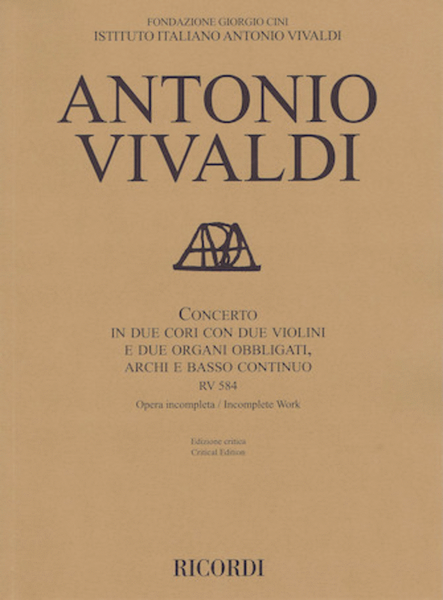Concerto Rv 584
in 2 Choirs 2 Violins & 2 (Mandatory) Organs, Basso Continuo Score
-
Ships in 24 hours
Details
Description
SKU: HL.50601157
In 2 Choirs 2 Violins & 2 (Mandatory) Organs, Basso Continuo Score. Composed by Antonio Vivaldi. Edited by Federico Maria Sardelli. Ensemble. Baroque, Classical. Softcover. 76 pages. Ricordi #PR1435. Published by Ricordi (HL.50601157).UPC: 888680739430. 7.75x10.5x0.245 inches. Critical edition by Federico Maria Sardelli.
Among the works by Vivaldi that are preserved incompletely, the Concerto in due cori con due violini e due organi obbligati, RV 584,stands out for its musical interest and structural complexity. It is a work of sumptuous and geometrical architecture composed to mark two special and concurrent events: the purchase - in 1737 - of a new large organ by the Ospedale della Pieta and the re-engagement of Vivaldi for a final time by this famous Venetian institution for foundlings as its "maestro dei concerti". From thetime of his first employment at the Pieta Vivaldi had composed concertos "in due cori" ("for double ensemble") in celebration of themost important liturgical and commemorative occasions; it was he who carried on, in the instrumental domain, the ancient Venetian tradition of polychoral music, leaving us six works that constitute the sole Italian examples of such writing. Recounting in detail the story of the purchase of, and repairs to, the organs of the Pieta in relation to Vivaldi's composition for this instrument, the introductory essay for this edition manages to mark out a precise chronological grid against which it is possible to date the work exactly. This investigation likewise produces a precise dating for the concerto RV 585, the earliest specimen of its kind, which was composed between September 1708 and February 1709. This 'story of the organs' additionally affords the opportunity to present an anthology of documents from the Pieta shedding light on the special relationship that existed between Vivaldi, the governors and the "figlie". Of this concerto, which was certainly composed in its entirety by Vivaldi and therefore - in all likelihood - also performed, there remains today only the autograph of the first, extended movement: enough to bear witness to the quality and impressiveness of the work and encourage its performance.

 Share
Share